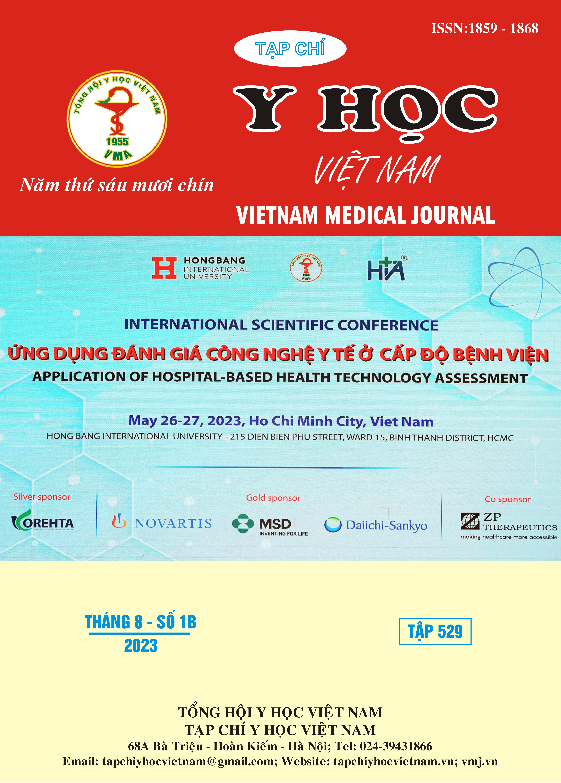RESULTS OF FLUOROLESS RADIO FREQUENCY CATHETER ABLATION USING THE THREE DIMENTIONS MAPPING SYSTEM FOR VENTRICULAR ARRHYTHMIAS FROM RIGHT VENTRICULAR OUTFLOW TRACT
Main Article Content
Abstract
Object: Evaluation of results of fluoroless radio frequency catheter ablation (CA) using the three-dimensions (3D) electroanatomic mapping (EAM) system for ventricular arrhythmias (VAs) originating from right ventricular outflow tract (RVOT). Methods: We conducted an observational, prospective study including 126 patients with RVOT VAs who were done CA at E hospital from March 2020 to October 2022. The patients were assigned to 2 different groups of either 3D EAM-used (fluoroless) or fluoroscopy-used group in a 1:1 ratio. Results: The 3D EAM-used group: Acute success rate was 98.4%, longterm success rate was 87.3%, minor and major complication rate was 4.8% (transient right bundle branch block and aneurysm), and 0.0%, respectively. Median radiation time was 0 second. The flouroscopy-used group: Acute success rate was 98.4%, longterm success rate was 84.1%, minor and major complication rate was 4.8% (transient right bundle branch block), and 0.0%, respectively. Median radiation time was 514 seconds. There were no significant difference between two groups in acute success rate, longterm success rate and complication rate with p value > 0.05. Conclusion: Flouroless radio frequency catheter ablation for RVOT VAs can be done safely and effectively by using the 3D electroanatomic mapping system. The results of fluoroless approach are comparable to that of the conventional fluoroscopy approach.
Article Details
Keywords
ventricular arrhythmias, right ventricular outflow tract, fluoroless radio frequency catheter ablation
References
2. Cronin EM, Bogun FM, Maury P, Peichl P, Chen M, Namboodiri N, et al. 2019 HRS/EHRA/APHRS/LAHRS expert consensus statement on catheter ablation of ventricular arrhythmias. Europace. 2019;21(8):1143-4.
3. Haegeli LM, Stutz L, Mohsen M, Wolber T, Brunckhorst C, On CJ, et al. Feasibility of zero or near zero fluoroscopy during catheter ablation procedures. Cardiology journal. 2019;26(3):226-32.
4. Kim YH, Chen SA, Ernst S, Guzman CE, Han S, Kalarus Z, et al. 2019 APHRS expert consensus statement on three-dimensional mapping systems for tachycardia developed in collaboration with HRS, EHRA, and LAHRS. J Arrhythm. 2020;36(2):215-70.
5. Heidbuchel H, Wittkampf FH, Vano E, Ernst S, Schilling R, Picano E, et al. Practical ways to reduce radiation dose for patients and staff during device implantations and electrophysiological procedures. Europace. 2014;16(7):946-64.
6. Zoppo F, Licciardello C, Favaro G, Scalon A, Bacchiega E, Lupo A, et al. Safety steps for a non-fluoroscopic approach in right-sided electrophysiology procedures: A point of view. Indian Pacing Electrophysiol J. 2019.
7. Kanitsoraphan C, Techorueangwiwat C, Rattanawong P, Kewcharoen J, Ayinapudi K, Bunch TJ, et al. Zero fluoroscopy approach versus fluoroscopy approach for cardiac arrhythmia ablations: A systematic review and meta-analysis. J Cardiovasc Electrophysiol. 2021; 32(10): 2761-76.
8. Wang Y, Chen GZ, Yao Y, Bai Y, Chu HM, Ma KZ, et al. Ablation of idiopathic ventricular arrhythmia using zero-fluoroscopy approach with equivalent efficacy and less fatigue: A multicenter comparative study. Medicine (Baltimore). 2017;96(6):e6080.


